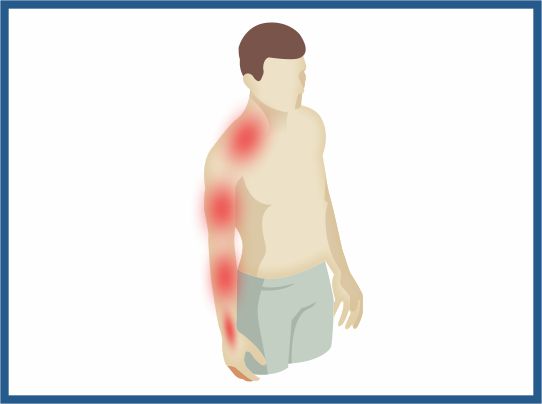Cervical Radiculopathy/ Pintched Nerve

Causes
Disc Herniation: A disc herniation occurs when a tear in the outer ring of the disc, called the annulus, allows central material of the disc, called the nucleus, to squeeze through the tear. The annular tear can happen at any place in the outer ring of the disc. Because the spinal canal is home to the spinal cord and nerves, the extra material can place pressure on the nerves. The disc material itself is very acidic and causes a chemical burn or irritation to the surrounding tissue. Together, pressure changes and an acidic environment can cause inflammation of the nerve roots and lead to cervical radiculopathy.
Bone Spurs Bone spurs form over time in response to arthritis or degenerative changes. Bone spurs can occur anywhere on the bone. When they form inside the foramen (or hole) where nerves exit through, this reduces the normal space available for a nerve root to “live” and causes irritation to the nerve. We call this foraminal stenosis. A nerve root being pinched by a bone spur can cause the same symptoms as a herniated disc since both processes can cause nerve irritation as the nerve exits the spinal cord in the neck.
Cervical foraminal stenosis When a foramen (bony opening where a nerve root exits the spinal canal) narrows and becomes smaller, the nerve root has less space and may become impinged. Degenerative changes related to cervical osteoarthritis and/or cervical degenerative disc disease may result in nearby bone spurs (osteophytes), thickening ligaments, or a bulging disc that pushes against the nerve root in the foramen. Cervical foraminal stenosis is the most common cause of cervical radiculopathy.
Other Causes of Cervical Radiculopathy While much less common, other potential causes of cervical radiculopathy include:
Fracture. If part of a vertebra becomes fractured, the resulting instability or foraminal narrowing in the cervical spine may impinge a nerve root.
Tumor A tumor, whether malignant or benign, may grow nearby and push against a nerve root.
Infection.
Various spinal infections and—less commonly—systemic infections can lead to inflammation and/or damage to a nerve root.
Sarcoidosis A rare disease that can cause granulomas (lumps) to grow on any organ in the body.
Symptoms
- Neck pain
- Pain, weakness, or numbness in the shoulders, arms, and legs.
- Hand clumsiness.
- Gait and balance disturbances.
- Burning sensations, tingling, and pins and needles in the involved extremity, such as the arm or leg.
- In severe cases, bladder and bowel problems.
- Although rare, severe cases can also cause significant loss of function or even paraplegia.
Treatment
Pain relievers
Antidepressants
Anti-seizure drugs
Opioids
Physical therapy
- Build up your strength and endurance
- Maintain the flexibility and stability of your spine
- Improve your balance
Steroid injections
Surgery
- Decompression procedure With this procedure, needle-like instruments are used to remove a portion of a thickened ligament in the back of the spinal column to increase spinal canal space and remove nerve root impingement.The procedure is called percutaneous image-guided lumbar decompression (PILD). It has also been called minimally invasive lumbar decompression (MILD).
- Laminectomy This procedure removes the back part (lamina) of the affected vertebra. A laminectomy is sometimes called decompression surgery because it eases the pressure on the nerves by creating more space around them.
- Laminotomy This procedure removes only a portion of the lamina, typically carving a hole just big enough to relieve the pressure in a particular spot.
- Laminoplasty This procedure is performed only on the vertebrae in the neck (cervical spine). It opens up the space within the spinal canal by creating a hinge on the lamina. Metal hardware bridges the gap in the opened section of the spine.
- Minimally invasive surgery This approach to surgery removes bone or lamina in a way that reduces the damage to nearby healthy tissue.

